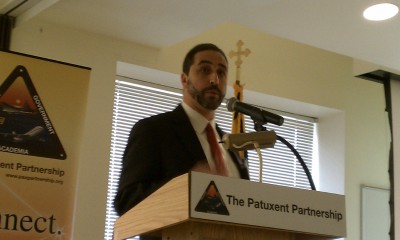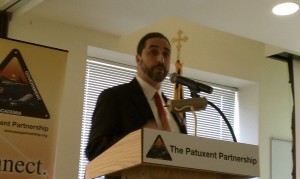Finding Submarines Using Very Cold Atoms

Posted for The Patuxent Partnership
Pax II
By Jay Friess
So, here’s how you build the next-generation submarine-hunting device:
You take a vacuum-sealed vessel with nothing in it (not even air) and fire a laser through it in six different directions. Then you inject a few atoms into this vessel, where they become suspended in the crossing laser beams. Then, if you tune the laser beams just right, you can cause the atoms’ electrons to go berzerk, jumping back and forth between energy states and draining energy off the atoms.
If you do this just right, the atoms get very cold.
How cold?
Colder than space. Micro kelvin. Near absolute zero. Once you have the lasers fired up, you can get this effect in two seconds. Once these atoms are frozen and being closely monitored by lasers, they get very sensitive to changes in gravity and magnetism, so you can use them to detect minute shifts in the density of the earth or water.
How does this find enemy submarines?
Well, you take this laser freezing device and you put it into an unmanned aircraft and you send it flying over the ocean …
How are you going to fit a laser table and a vacuum chamber in a UAV!?
Exactly!, it’s not a simple problem, and that’s what engineers down at the applied physics laboratory at St. Mary’s College of Maryland are helping the Naval Air Systems Command work on right now. Earlier this year, The Patuxent Partnership gave a $1 million grant to the college to fund research into this problem.
On Wednesday, the Partnership invited Dr. Frank Narducci, a NAVAIR physicist, to speak at its annual meeting about the latest prospects for this laser technology. Dr. Narducci said the NAVAIR team and the College are working to miniaturize the technology for use on the new P-8A Poseidon submarine hunter and the upcoming MQ-4C Triton UAV.
Once miniaturized, the technology could be used to find insurgent tunnels in the mountains of Afghanistan, create a guidance device as accurate as a GPS (without dependence on satellites), or eliminate magnetic interference readings for sub hunting aircraft.
“We figured out how to get rid of [magnetic] noise using this device,” Dr. Narducci said, noting that this will be a big help for the P-8A, which flies tens of thousands of feet above its targets.
Dr. Narducci said that NAVAIR currently has five applied physics students employed in its labs, and St. Mary’s College has six. The basic research these labs are conducting will form the basis of tomorrow’s engineering marvels at NAVAIR.
“Physics is both a precursor and a partner to the world of engineering,” Dr. Narducci said.
























